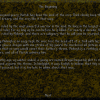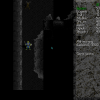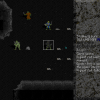Overview
Natuk is a traditional overhead party-based role-playing game with a focus on detailed tactical combat that appeals most to those often referred to as “hardcore” role-players. Its predecessor, Nahlakh, was based on the pen-and-paper role-playing game GURPS by Steve Jackson Games,and Natuk moved to a percentile-based system reminiscent of the Rolemaster system by Iron Crown Enterprises (ICE)—both complex and detailed skill-based rules systems that avoid the abstract hit-point system used by most games derived from TSR’s Dungeons & Dragons and instead use specific-body-part damage rules. Natuk bears similarities to such diverse computer RPG games as the Ultima series (1980-present), Wizard’s Crown (1985), the Phantasie series (1986-87), and Interplay’s celebrated Fallout (1989).
The game was released on a shareware distribution model, with the shareware version being approximately one-third of the game. In later years, the game was distributed completely, as freeware.
The Story
You control a party of eight orcs, ogres and half-trolls on a quest for revenge against the cruel emperor Molvosh. As the story goes, your characters committed a bungled assassination attempt, and the emperor had all your family killed, the plot leader flayed alive, and the accomplices (your party) thrown into the prisons of Jagg. However, due to bureaucratic error, your party was instead merely assigned to a remote outpost on the frontier. From there, you leave the outpost; traverse the wilderness; explore caves, dungeons, orcish towns and other locations; get into orcish barfights; and eventually extract your revenge from Molvosh himself.
Gameplay
As alluded to above, Natuk is a hybrid class- and skill-based RPG in the mold of Rolemaster. Thus, for each character you select a starting class (including such orcish professions as Scout, Assassin, Warrior, and Witchdoctor), which determines your beginning skills and aptitudes, but from there you are free to develop your characters as you see fit. Even spellcasting is not limited to the magic-wielding classes, and thus the dim-witted half-troll warrior can learn some magic if you choose to spend his skill points so, though he’ll never excel at it.
Instead of gaining “levels,” each character gradually gains skill points, which he can spend at any time. As a skill improves, the cost to improve it increases, so, as in the pen-and-paper RPGs upon which Natuk is based, you must choose between developing a generalist who is adequate at a wide variety of skills, a highly-trained specialist, or something inbetween. But either way, you are not limited to set archetypes, and the game allows creative individualized hybridization of your characters.
Movement on the world map is conducted in real-time, in a style similar to that of Microprose’s Darklands and Interplay’s Fallout. Movement between locations is punctuated by random encounters such as wandering trade caravans, friendly orcish patrols, hostile orcish bandits that look like friendly patrols, and, of course, outright hostiles. Sometimes your choice of action can steer an encounter one way or the other.
Town adventuring is very close to that seen in Wizard’s Crown; the town map is divided into squares of urban landscape, many of which contain some distinguishing feature, such as a temple, a tavern or a shop, that is only discovered upon entering that square.
In adventuring locales, where the bulk of gameplay occurs, all characters and objects are depicted as if from the side (in similar style to the Ultima games). The character selected as the group leader is the one shown as you explore, interacting with non-player characters, objects, containers and, of course, enemies.
When combat occurs, there is no separate “closeup” combat map as there is in many games; the adventure area doubles as the combat map, similar (again) to the Ultima Series. Your full party is now shown grouped close to your lead character, and tactical combat begins. At first blush, Natuk’s combat appears similar to combat in the older style of turn-based RPGs like SSI’s original Pool of Radiance and other like games in the Gold Box Series. Combat is turn-based, with individualized initiative determined and each character allotted a certain number of movement points. However, attack options and the method of resolving them are far more complex and involved, similar to those of Fallout (which was itself based on a system similar to GURPS), with such features as parrying, feinting, aiming for different areas of the body (head, eyes, arms, vitals, etc.). The resulting critical hits are brutal, and can involve blindness, crippling and premature death (premature?). With combat this involved, though, tedious combats can be resolved via a quick-combat option.
The magic system is syllable-based, like that of the Ultima Series, with each spell composed of three syllables of a magic language that create or modify different effects. For example, Wubisiz (typing the letters W, B and I) casts “create ice,” while Wubisdel (W, B and D) casts “create fog.” Success or failure is determined by either the character’s magic skill or her chanting skill, and spells can be learned from spellbooks or figured out by trial-and-error. Thus, if you know Rakhimxa (Rak=throw, Him=little, and Xa=stone), and figure out that Gokh means shock, you can have a character cast Rakhimgokh (throw little shock), after which point he will be able to cast that spell without you having to type it in yourself. There are no “magic points,” however. Instead, spellcasting drains characters’ strength.
Following a strange tradition of role-playing games (and not just computer ones), in Natuk you begin facing… rats. Giant rats. Eventually, though, you move on to face other orcs and orc-kin (ogres, trolls, etc.), evil cultists, hostile spellcasters, demons, dragons, and a variety of other enemies. The game offers a variety of situations and game locations to explore, but combat is the most prevalent and almost all objects found in the game revolve around it; thus, Natuk would be best described as an adventure RPG with a particular emphasis upon tactical combat. However, like another older game with the same theme—Firebird’s Knight Orc—the game has a distinctly “Orcish” feel to it, replete with party members picking on each other and getting into tiffs.



